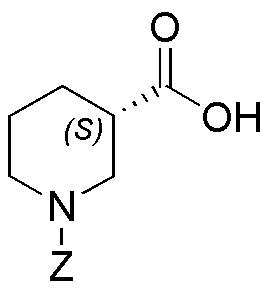Z-L-nipecotic acid is widely utilized in research focused on
- Neuroscience: It serves as a valuable tool in studying neurotransmitter systems, particularly in understanding the role of GABA receptors, which are crucial for brain function.
- Pharmaceutical Development: This compound is used in the synthesis of new drugs aimed at treating neurological disorders, offering potential therapeutic benefits for conditions like epilepsy and anxiety.
- Analytical Chemistry: Z-L-nipecotic acid is employed as a standard in chromatographic methods, aiding researchers in the accurate identification and quantification of related compounds in complex mixtures.
- Biochemistry: It plays a role in enzyme inhibition studies, helping researchers explore the mechanisms of action for various biochemical pathways.
- Drug Formulation: The compound is utilized in creating formulations that enhance the bioavailability of therapeutic agents, making medications more effective for patients.
General Information
Properties
Safety and Regulations
Applications
Z-L-nipecotic acid is widely utilized in research focused on
- Neuroscience: It serves as a valuable tool in studying neurotransmitter systems, particularly in understanding the role of GABA receptors, which are crucial for brain function.
- Pharmaceutical Development: This compound is used in the synthesis of new drugs aimed at treating neurological disorders, offering potential therapeutic benefits for conditions like epilepsy and anxiety.
- Analytical Chemistry: Z-L-nipecotic acid is employed as a standard in chromatographic methods, aiding researchers in the accurate identification and quantification of related compounds in complex mixtures.
- Biochemistry: It plays a role in enzyme inhibition studies, helping researchers explore the mechanisms of action for various biochemical pathways.
- Drug Formulation: The compound is utilized in creating formulations that enhance the bioavailability of therapeutic agents, making medications more effective for patients.
Documents
Safety Data Sheets (SDS)
The SDS provides comprehensive safety information on handling, storage, and disposal of the product.
Product Specification (PS)
The PS provides a comprehensive breakdown of the product’s properties, including chemical composition, physical state, purity, and storage requirements. It also details acceptable quality ranges and the product's intended applications.
Certificates of Analysis (COA)
Search for Certificates of Analysis (COA) by entering the products Lot Number. Lot and Batch Numbers can be found on a product’s label following the words ‘Lot’ or ‘Batch’.
*Catalog Number
*Lot Number
Certificates Of Origin (COO)
This COO confirms the country where the product was manufactured, and also details the materials and components used in it and whether it is derived from natural, synthetic, or other specific sources. This certificate may be required for customs, trade, and regulatory compliance.
*Catalog Number
*Lot Number
Safety Data Sheets (SDS)
The SDS provides comprehensive safety information on handling, storage, and disposal of the product.
DownloadProduct Specification (PS)
The PS provides a comprehensive breakdown of the product’s properties, including chemical composition, physical state, purity, and storage requirements. It also details acceptable quality ranges and the product's intended applications.
DownloadCertificates of Analysis (COA)
Search for Certificates of Analysis (COA) by entering the products Lot Number. Lot and Batch Numbers can be found on a product’s label following the words ‘Lot’ or ‘Batch’.
*Catalog Number
*Lot Number
Certificates Of Origin (COO)
This COO confirms the country where the product was manufactured, and also details the materials and components used in it and whether it is derived from natural, synthetic, or other specific sources. This certificate may be required for customs, trade, and regulatory compliance.


